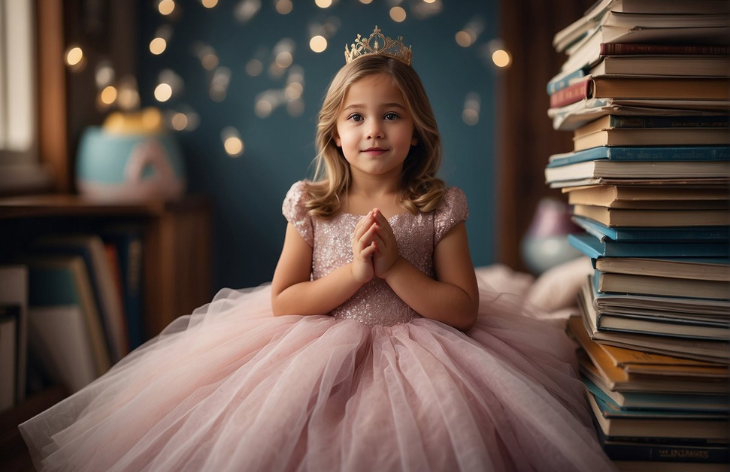When your daughter chooses to don a shimmering tiara and a flowing gown in spirited play, she’s doing more than just playing dress-up. She’s engaging in a rite of childhood that taps into her fascination and sense of wonder.
The sight of little ones twirling in princess dresses may seem trivial, but could these royal ensembles signify more beneath their glittery surface? Do they shape or reflect the way our daughters see themselves and their possibilities?
Princess culture has permeated childhood, with its narratives often serving as a child’s first encounter with storytelling. As a parent, you might wonder about the impact of these tales of rescue and romance.
What does it mean when playtime often involves a royal persona, and how does it influence children’s development and identity?
Key Takeaways
- Choosing princess attire is a common and imaginative part of childhood play.
- The implications of princess culture warrant a nuanced examination by parents.
- Reflect on how princess stories might shape a child’s perception of self and aspiration.
Shannon’s Take
Understanding Princess Culture in Fantasy
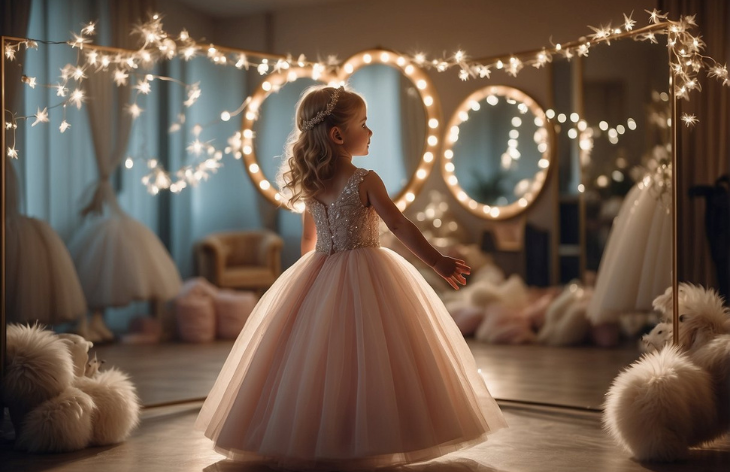
When you think about princess culture, you’re delving into a world where fairy tales, gender roles, and media intersect. It’s a place where traditional femininity is celebrated and often commodified, influencing not just what your daughter may choose to wear, but her sense of self.
The Allure of the Princess Archetype
Within this culture lies a powerful archetype that resonates with many young children. Princesses like Cinderella and Belle represent qualities that are traditionally seen as desirable in girls: kindness, beauty, and an innate ability to care for others.
These characters typically wear extravagant dresses that reinforce their royal status and femininity. This archetype often blends characteristics like grace and resilience with the pursuit of romance and adventure, creating an enticing vision of what it means to be ‘girly’.
Gender roles are at play here, as the archetype usually embodies the qualities expected from traditional feminine norms.
The ‘tiara‘ your daughter dons isn’t just a glittery accessory—it’s a symbol of a role she’s trying out within a very specific framework of expectations. This fascination with princesses can be seen as both an expression of ‘super cute’ fantasy play and a complex navigation of gender stereotypes.
Influence of Disney on Princess Dresses
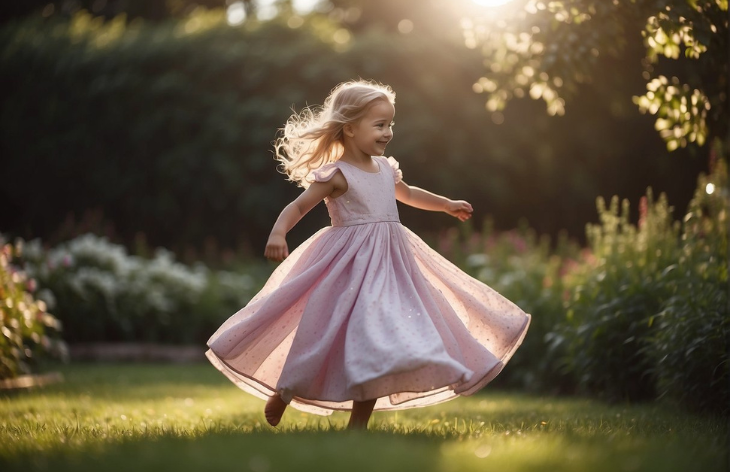
Disney’s impact on this culture is monumental. Characters like Elsa, Ariel, and Jasmine bring vibrant stories to the screen, alongside stunning dresses that capture your daughter’s fascination.
Disney has shaped the idea of the modern royalty with its animated films, merchandise, and theme park experiences. It’s no surprise that Disney Princess dresses are often the go-to choice for young fans eager to look as regal, brave, or adventurous as their favorite characters.
However, this culture is not without controversy. Some feminist perspectives criticize it for reinforcing a narrow view of femininity centered on beauty and domesticity.
Despite this, Disney has taken strides to diversify their lineup with characters like Tiana and Moana, offering more varied representations of what it means to be royal. This evolution allows your daughter to see past the ‘cute little’ narratives to stories of empowerment and self-discovery, challenging some of the stereotypes that have historically been attached to these royal figures.
Parenting Perspectives on Daughters Wearing Princess Dresses
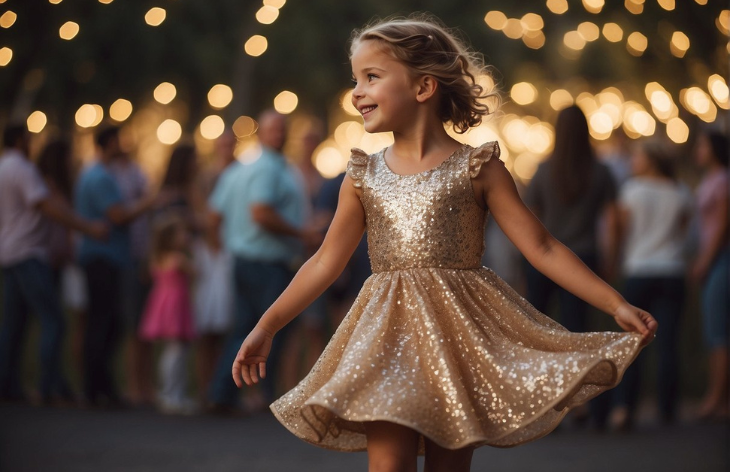
When your daughter comes to you with wide eyes, holding a glittery princess dress, it’s not just about the tulle and sequins. As a parent, recognizing the layers of importance behind this choice is key to nurturing her development and self-expression.
Encouraging Expression and Imagination
Your six-year-old might insist on wearing her favorite tutu to the grocery store, asserting her identity as a little princess.
Psychologists affirm the value of imaginative play in kids’ development, supporting the idea that wearing a princess dress encourages creativity and helps your child express their individuality.
When your 3 year old daughter or four-year-old wraps herself in a royalty ensemble, she’s not just playing dress-up; she’s navigating her world through a lens of wonder and exploration.
- Expression: Allowing your daughter to wear these dresses can be a way of letting her express her emerging personality.
- Imagination: Through dressing up, girls’ engage in imaginative play that experts suggest is crucial for child development.
Dressing Up: Beyond a Simple Outfit
Dressing up is more than donning a costume; it’s about the experiences that the dress enables.
Clinical psychologists note that when your daughter wears a sparkly dress, she’s not aiming to be a damsel in distress but rather enjoying a form of self-expression that promotes her ability to thrive.
Whether it’s a tutu or a full gown, the act of dressing up provides an opportunity for children to experiment with different facets of their burgeoning self-identity.
- Choice: If your daughter loves the feeling of tulle around her and chooses to dress like a monarch, it’s a personal choice reflecting her preferences.
- Development: The simple act of choosing a glittery skirt or a sparkly outfit can reinforce decision-making skills and confidence.
Frequently Asked Questions
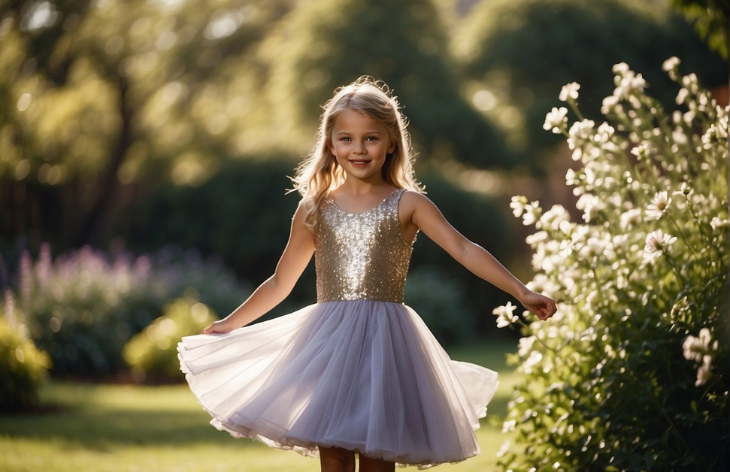
When your daughter shows a fondness for empress dresses, it’s important to understand how to support her and what this preference might mean from various perspectives.
How can parents support healthy self-expression in children who enjoy princess-themed attire?
You can encourage your child’s fascination and individuality by providing a variety of dress-up options, including costumes. Affirmation and open-ended questions about their dress-up play can foster creativity and ensure that their interest in princess attire is a positive experience.
What are the psychological implications of a child’s preference for dressing like a princess?
A preference for dressing like a princess can be a normal part of pretend play, which helps with emotional development and problem-solving. However, it’s important to promote diverse role models to prevent stereotypical views about gender from taking root.
What is the definition of a princess-line dress in fashion terms?
In fashion, this dress refers to a style that has long, vertical seams that create a form-fitting shape without a visible waistline. This cut can be traced from the armhole to the hem and is designed to flatter the body’s contours.
How should parents address concerns about inappropriate dressing in children?
When addressing concerns about dressing appropriately, it’s vital to set clear guidelines that respect your child’s choices while explaining the importance of occasion-appropriate attire. Engage in a dialogue to understand their preferences and guide them towards suitable options.
Are there any educational benefits to children dressing up as characters, such as princesses?
Dressing up as characters can offer educational benefits like enhancing language skills and social understanding. It allows children to experiment with different roles, which can aid in developing empathy and emotional intelligence.

